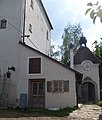Forstern Castle
The Castle Forstern is located in the district of Forstern the town of Burg churches in the district Braunau .
history

The castle is first mentioned in a document in the traditions of the Passau bishopric between 1013 and 1045. A Dietrich de Vorstarn is mentioned in the Ranshofen code of tradition in 1180 , and Forstern's entry is found much later in a document dated February 3, 1358 (with the “inheritance of Her Conradt der Notleich von Vornstorn” ). In 1383 a Chunrat Neusslinger on Forstern is mentioned, in 1403 Steffan der Egker, judge von Weilhart, is recorded here. In 1484, a dispute between Georg Neyslinger, Stephan Ekker (pastor of Aurolzmünster ), Lienhart Pugenhover and Adam Seybersdorffer is said to have broken out over the residence . The noble seat Forstern was listed in the land table of 1490 as Hofmark and owned the lower jurisdiction.
In 1504, Duke Albrecht of Bavaria-Munich gave the Hofmark to the city of Braunau am Inn as a replacement for war damage suffered in the Landshut War of Succession . In 1536 the property was marked out and liberated. From now on, the mayor and councilor of Braunau appointed a fiefdom holder from among them who administered the Forstern seat. The first fief carrier was the councilor Konrad Stadler. Around 1597, Karl Eisenreich is mentioned as the caretaker. The deed of mortgage dated February 7, 1838 was issued for Josef Schüdl by Emperor Ferdinand I after the death of Josef Moser . The last loan from the same Josef Schüdl was made by Franz Joseph I on October 2, 1850.
In 1850 the town of Braunau sold the residence to Johann Futschik. Other owners were Peter Endl (1901–1904), Anton Simeth (until 1913), Georg Baier (until 1953) and then the family Josef and Theresia Zöhner are named as owners.
Forstern Castle today
Forstern gives the impression of a typical residence , as you can find it especially in South Tyrol . For the residences of the lower nobility there were precise regulations on the number of floors, the ditch, the cellar and the forbidden fortifications. Since a mansion was not very well-defended, it hardly played a role in armed conflicts, which is why the evidence of such a building is rare.
Around the building you can still see a ditch that could be filled with the water from the Mattig , as can be seen in the engraving by Michael Wening from 1721. Due to the regulation of the Mattig the moat has been drained today and the bridge leading to the residence has disappeared. The shape of the roof has also changed and is now less steep than in the past and is no longer hipped.
The building is still three-story today. The former side bay windows have disappeared, but there is a small entrance tower. The former gatehouse is still recognizable as a farmhouse today. Still hunting a holy is Nicholas of Myra consecrated chapel available to be re-consecrated on 23 June 2012 found. In front of the entrance staircase is a fountain that was renewed in 2012. The current owner Manhartseder-Krisai has already pushed the renovation of the listed building far ahead.
literature
- Oskar Hille: Castles and palaces in Upper Austria then and now. Verlag Ferdinand Berger & Sons, Horn 1975, ISBN 3-85028-023-3 .
- Norbert Grabherr : Castles and palaces in Upper Austria. A guide for castle hikers and friends of home. 3rd edition . Oberösterreichischer Landesverlag, Linz 1976, ISBN 3-85214-157-5 .
- Georg Grüll : Castles and palaces in Upper Austria, Volume 2: Innviertel and Alpine foothills . Birken-Verlag, Vienna 1964.
- Christian K. Steingruber : A critical consideration of the historical-topographical manual by Norbert Grabherr . Upper Austrian Provincial Archives , Linz 2019.
Web links
- Entry via Forstern Castle to Burgen-Austria
- Burgkirchen special page
Individual evidence
- ↑ George Clam Matinic: castles in Austria. Landesverlag im Veritas Verlag, Linz 1991, p. 226.
- ↑ Georg Grüll, 1964, pp. 49–51.
Coordinates: 48 ° 12 '43.3 " N , 13 ° 5' 54.7" E




